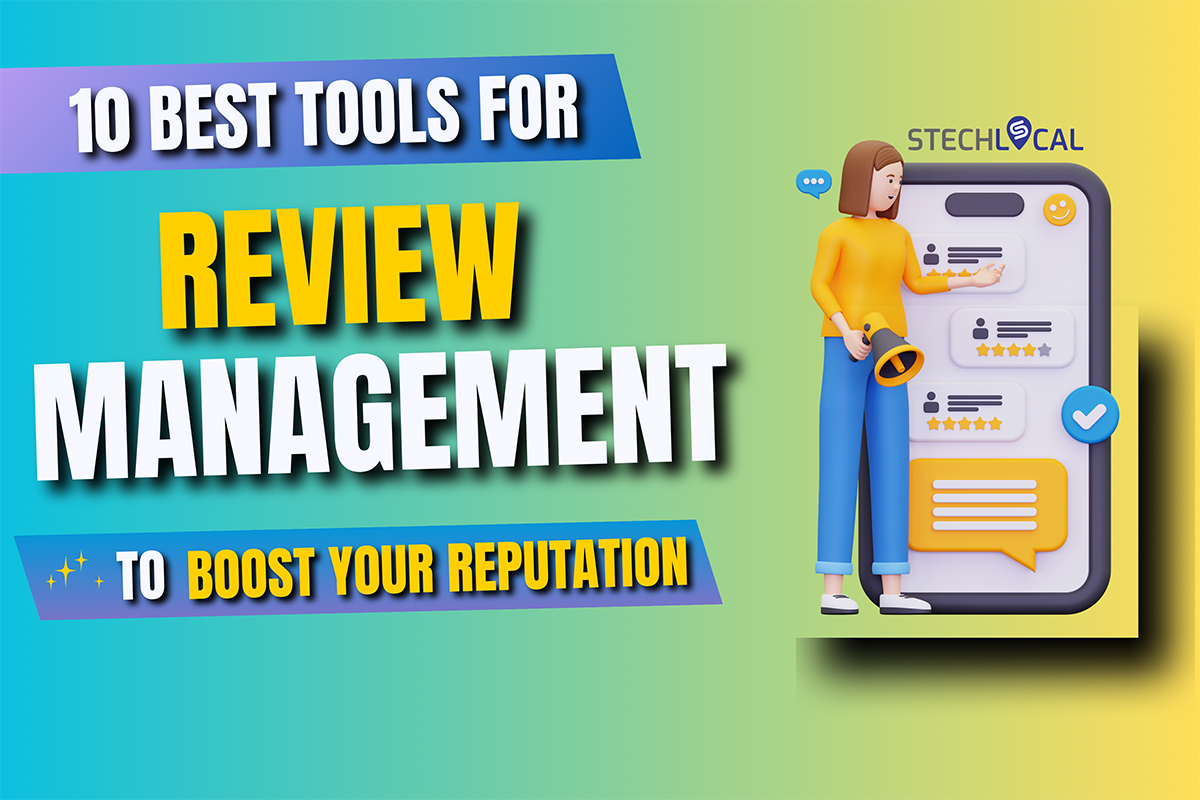Google Reviews Impact on Local SEO

If you’re a business owner or agency not actively managing reviews, you’re leaving local SEO performance and revenue on the table.
In 2025, Google Reviews are no longer just testimonials — they are trust signals that directly impact your visibility, rankings, and conversions in local search.
As Google continues to refine its algorithm, there has been a fundamental shift from link building to trust building. Today, trust is the currency of local SEO, and nothing builds that faster than real, authentic feedback from your customers.
Let’s thoroughly understand how Google reviews impact Local SEO and everything revolving around it.
Role of Google Reviews in Google’s Local Search Algorithm
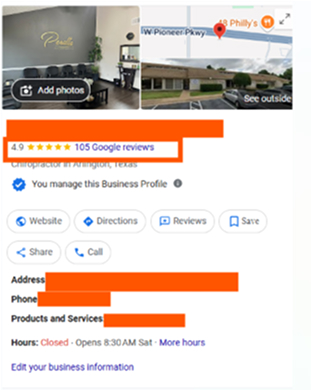
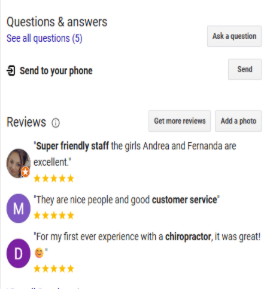
When it comes to local search optimization, Google Reviews have become a foundational ranking signal. Now, they are not supplemental — they are core components of Google’s local algorithm, directly influencing where and how your business appears in Google Maps, the Local Pack (Map Pack), and localized search results.
“In industries like legal, medical, and home services, a single keyword-rich review mentioning the city name and service type can help listings jump by 1–2 positions in the Local Pack within 72 hours — especially in low-competition zip codes.” — Akmal Faizan, Founder, Stech Local
Where Do Google Reviews Fit Into the Algorithm?
Google’s local ranking algorithm is driven by three primary factors:
- Relevance – How well a local listing matches a user’s search intent.
- Distance – How close the business is to the searcher’s location.
- Prominence – How well-known and reputable the business is.
Google Reviews heavily influence the "Prominence" factor. When a business has a consistent flow of positive, high-quality reviews, it signals to Google that the business is active, trusted, and valued by its local community.
Furthermore, reviews that contain localized keywords, product or service mentions, and user experiences help Google better understand the context and expertise of your business. This enhances semantic relevance, making your profile more likely to appear for high-converting, location-based search queries.
Example:
“The best HVAC repair in Dallas — super fast service and great pricing!” reinforces the business’s location relevance, service category, and customer satisfaction, all of which are interpreted by Google’s machine learning systems.
Top 7 Google Reviews Impact on Local SEO
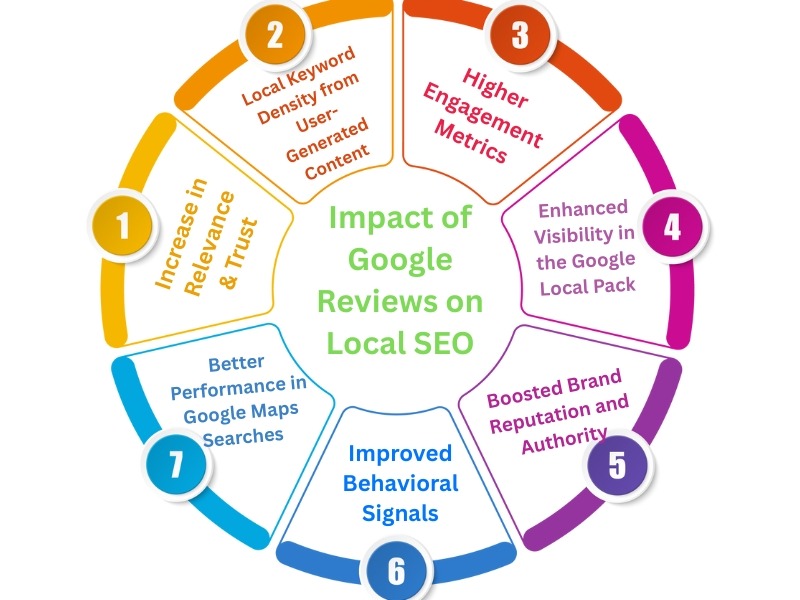
Following pointers that explain how Google reviews directly and indirectly improve your local SEO performance:
1. Increase in Relevance and Trust
Every time a customer leaves a review, they’re adding contextual signals to your Google Business Profile (GBP).
Reviews that mention specific services, products, or outcomes help Google understand what your business is truly about — especially when paired with strong star ratings.
For example, a review like “I hired this landscaping company in Tampa for backyard remodeling and they did a phenomenal job” builds topical relevance and geo-relevance in one sentence.
As trust is a pillar of Google’s E-E-A-T guidelines, consistently positive reviews validate your credibility to both users and search engines.
In 2025, Google’s algorithm uses advanced natural language processing (NLP) to extract sentiment, intent, and topical relevance from reviews. It evaluates:
- Review sentiment (positive, negative, neutral)
- Contextual keywords (services offered, specialties)
- Review frequency and freshness
- Engagement signals (likes, owner responses)
Each of these factors plays a role in determining a business’s local relevance score, which directly influences whether your listing is surfaced for competitive keywords like “best lawyer near me” or “affordable marketing agency in Austin.”
2. Local Keyword Density from User-Generated Content
Unlike traditional on-page SEO, reviews are a powerful source of user-generated keywords. Google’s algorithm parses these reviews for:
- Service-related phrases
- Location mentions
- Long-tail keywords
These naturally written, keyword-rich statements can boost your visibility for real-world search queries like “best family lawyer in Austin” or “emergency plumber open now in Chicago.”
The more varied and descriptive your reviews, the broader your keyword footprint — without any manual keyword stuffing.
3. Higher Engagement Metrics (CTR, Dwell Time)
Google tracks how users interact with your listing. A well-reviewed business naturally enjoys:
- Higher click-through rates (CTR) due to compelling star ratings
- Increased dwell time as users read reviews
- Lower bounce rates because users find what they need quickly
These behavioral metrics signal to Google that your listing is valuable, relevant, and satisfying user intent — all of which contribute to higher rankings.
Businesses with visible 4.5+ star ratings often see 30%–50% higher CTR in the Local Pack.
4. Enhanced Visibility in the Google Local Pack
The Local Pack — that box of three businesses that appears at the top of local search results — is a prized position. Studies show it receives over 44% of total clicks for location-based searches.
To consistently rank here, your business must outperform competitors in several key areas — and review signals are one of the top ranking factors.
Google favors businesses that demonstrate:
- A steady stream of new reviews
- High average ratings (typically 4.2+)
- Recent engagement from both customers and owners
More reviews = more ranking power, especially for proximity-based searches like “best [service] near me.”
5. Boosted Brand Reputation and Authority
In today’s trust-driven digital landscape, reviews build social proof that amplifies your brand authority. A strong review profile:
- Establishes credibility for new customers
- Differentiates your business from competitors
- Increases conversion rate across all touchpoints
Google’s algorithm interprets this widespread trust as a sign of prominence, which directly influences your place in the local search ecosystem.
Pro tip: Even one viral 5-star review with a detailed story can boost your perceived brand authority in a niche market.
6. Improved Behavioral Signals
Positive review profiles influence user behavior beyond the SERP:
- Customers are more likely to click, call, and convert
- They spend more time engaging with your business profile
- They are more likely to visit your website or use direction/navigation features
Google interprets these behavioral signals as intent satisfaction — indicating your listing is delivering a quality experience, which reinforces higher rankings.
7. Better Performance in Google Maps Searches
Google Maps isn’t just a navigation tool — it’s a search engine for local discovery. When users search on Maps, reviews are one of the primary sorting mechanisms.
Since Maps listings often influence in-the-moment decisions, optimizing your review strategy significantly boosts foot traffic and local conversions. Businesses with strong reviews get:
- Higher rankings in Maps search results
- Better visibility on mobile devices
- More action triggers (calls, visits, direction requests)
Google Review Quantity vs. Quality vs. Recency: What Matters Most?
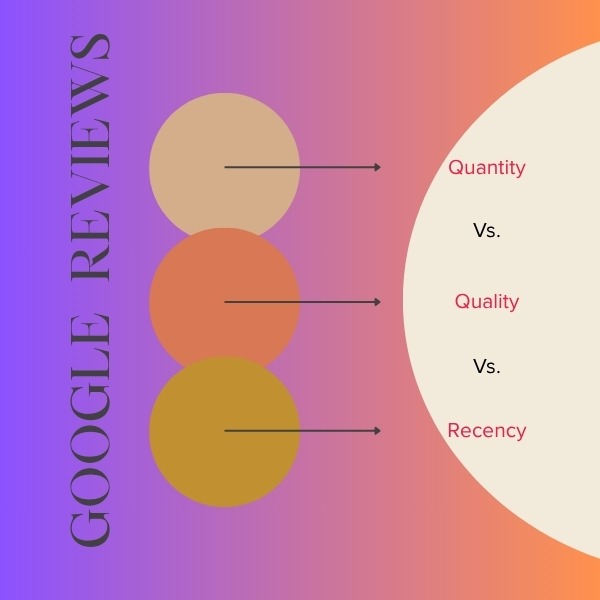
Regarding ranking in Google’s local search ecosystem, not all reviews are created equal. The most successful local SEO strategies are built on a balanced approach that considers quantity, quality, and recency — each of which plays a unique role in how Google evaluates your business.
1. Review Quantity: Strength in Numbers (But Not Alone)
Google uses the total number of reviews as a signal of a business’s popularity and credibility. Businesses with a higher volume of reviews are often considered more trusted, especially when compared to competitors with similar service offerings but fewer reviews.
However, sheer quantity alone won’t boost rankings unless those reviews are:
- Authentic (not spammy or duplicated)
- Varied in language and content
- Spread out over time
A business with 250 reviews from the past 6 years is less impactful than one with 75 recent, relevant reviews in the past 12 months.
So, to make an impact in the long run, make review generation part of your ongoing customer journey — not a one-time campaign.
2. Review Quality: Content-Rich, Specific, and Sentiment-Driven
Review quality is where the real SEO power lies. Google evaluates the depth, sentiment, and keyword relevance of individual reviews using natural language processing (NLP). This helps determine:
- How well the business meets user expectations
- What services or locations are mentioned
- Whether the tone is positive, neutral, or negative
Detailed, experience-based reviews that mention specific services, outcomes, and local context are more valuable than generic 5-star ratings with no text.
Instead of: “Great service!”
Aim for: “I visited Stech Dental in Atlanta for an emergency root canal, and Dr. Miller’s team had me pain-free in under an hour!”
These descriptive reviews:
- Boost local keyword density
- Strengthen Google’s understanding of your expertise
- Influence user behavior (CTR, conversions, etc.)
3. Review Recency: Freshness Signals Relevance
Recency is a major factor in Google’s trust equation. A steady stream of new reviews shows that your business is active, relevant, and currently delivering value. It is something that both users and Google’s algorithm prioritize.
Stale review profiles, even if highly rated signals inactivity. That can hurt your visibility in:
- Google Maps
- Local Pack results
- “Near Me” searches
Google favors listings with reviews from the last 2–3 weeks over those that haven’t seen activity in months — even if the older profile has more total reviews.
Recency matters especially for:
- Seasonal businesses (e.g., tax services, landscaping)
- High-competition niches (e.g., lawyers, med spas)
- Businesses recovering from reputation damage
So, What Matters Most?
|
Factor |
SEO Impact |
Why It Matters |
|
Quantity |
Medium–High |
Builds baseline trust and authority |
|
Quality |
Very High |
Drives keyword relevance, sentiment, and context |
|
Recency |
High |
Signals current relevance and active engagement |
The Science Behind Review Signals: What Google Looks At
Now Google uses machine learning and natural language processing (NLP) to assess multiple layers of data from your reviews — not just their presence, but what they say, how users interact with them, and how you respond.
Let’s explore the core review signals Google analyzes when ranking local businesses.
1. Total Review Count
- What it signals: Overall popularity and engagement
- Why it matters: A higher number of reviews (especially across locations or service lines) shows Google that your business is active and well-established in the local market.
- Pro tip: Spread reviews across all your business locations and services to support multi-location SEO.
2. Average Star Rating
- What it signals: Perceived service quality and customer satisfaction
- Why it matters: Businesses with ratings between 4.2–4.8 perform better in the Local Pack and Maps.
A perfect 5.0 rating with only a few reviews may look suspicious, while a 4.5 rating across hundreds signals authenticity and credibility.
- Warning: Dropping below a 4.0 average can significantly reduce clicks and conversions.
3. Review Sentiment and Context
- What it signals: Depth and tone of customer experience
- Why it matters: Google uses NLP models to read review content and determine:
- Sentiment (positive, negative, neutral)
- Topics and services discussed
- Relevance to local queries
For example, a review mentioning “urgent root canal in Houston” helps Google associate your business with:
- A specific service (root canal)
- A location (Houston)
- A use case (emergency dental care)
4. Review Frequency (Velocity)
- What it signals: Ongoing customer activity and freshness
- Why it matters: A steady flow of reviews over time tells Google that your business is continuously serving customers. Spikes followed by silence can look unnatural and may even trigger spam filters.
- Benchmark: Aim for weekly review activity, especially in high-competition niches.
5. Review Diversity
- What it signals: Broad, balanced feedback from real users
- Why it matters: Google values review profiles with:
- Reviews from verified local guides
- Varied length and tone
- Both praise and constructive criticism
- Different platforms (when linked from your site or review aggregator)
6. Owner Responses
- What it signals: Business engagement and trustworthiness
- Why it matters: Google sees regular responses to reviews — especially negative ones — as a sign of active business management. It improves trust signals, reduces bounce rate, and supports reputation recovery.
Businesses that respond to 100% of reviews are perceived as 47% more trustworthy by users — and are more likely to get repeat visits and map actions.
7. Keywords in Reviews
- What it signals: Topical and local relevance
- Why it matters: Google scans reviews for service names, problems solved, benefits experienced, and location keywords. These words help Google match your listing to more varied search queries.
Local Pack vs. Organic: How Google Reviews Influence Both
Google Reviews are a powerful force in both local (Map Pack) and traditional organic SEO.
Let’s explore how reviews impact both layers of search visibility — and why your review strategy must support both.
1. Visibility in Google Maps and the Local 3-Pack
The Local Pack is the group of three business listings that appear prominently in search results for local queries (e.g., “civil lawyer near me” or “best Thai restaurant in Austin”).
The number of reviews, average star rating, and frequency of new reviews are all ranking factors that help determine which businesses earn a spot in the top 3.
2. Indirect Influence on Organic (Traditional) Rankings
While reviews don’t directly boost your site’s traditional organic position (like backlinks or content quality do), they indirectly impact core SEO signals in powerful ways:
Behavioral Signals Boosted by Reviews:
- Higher Click-Through Rates (CTR): Listings with visible 4+ star ratings attract more clicks.
“Listings with 4.5+ star ratings see significantly higher CTR — Search Engine Land has shown this direct correlation in recent studies.”
- Increased Dwell Time: Users spend more time reading reviews on your GBP or site.
- Lower Bounce Rate: Satisfied users are more likely to continue exploring your site after arriving from search.
On-Site Integration of Reviews:
- Embedding Google Reviews (with schema markup) on landing pages increases:
- Keyword density
- Topical relevance
- Social proof that builds trust with both users and search engines
3. Role in Branded vs. Non-Branded Search Queries
Google reviews significantly impact your visibility and credibility in both branded and discovery searches:
Branded Search (e.g., “Stech Local reviews”)
- Users actively researching your business will often scan your reviews before clicking.
- A strong review profile improves brand perception and trust, increasing clicks and conversions.
Non-Branded/Discovery Search (e.g., “best SEO tool for local business”)
- Google pulls businesses into the results based on review relevance.
- Keywords mentioned in reviews can surface your business for related terms you didn’t directly optimize for.
How Google Reviews Affect Click-Through Rate and User Behavior
In today’s competitive local search environment, winning visibility is just half the battle — converting that visibility into engagement is where the real value lies.
Beyond their impact on rankings, Google reviews have a powerful psychological and behavioral effect on how users interact with your business across search, maps, and even your website.
1. Google Star Ratings Directly Improve Click-Through Rates (CTR)
Star ratings in search results, especially when shown in the Google Local Pack or on organic listings using review schema, dramatically increase your chances of earning a click.
According to Google’s Think with Google, 76% of mobile local searches lead to a visit within 24 hours, and 28% result in a purchase or in-store visit within that same time frame.
- Listings with 4.5+ star ratings can see 30% to 40% higher CTR compared to those without ratings or with poor ratings.
- A visible count of high-quality, recent reviews signals credibility at first glance — which matters, especially in high-intent searches like “best urgent care near me”.
2. Reviews Influence Dwell Time and On-Listing Engagement
Once a user clicks your profile or website, reviews serve as trust-building content that holds their attention:
- Users often scroll through your review feed, read both positive and negative reviews, and observe how you respond.
- This activity increases dwell time — the amount of time a user spends before returning to the SERP — which Google can interpret as a positive signal of relevance and satisfaction.
|
Higher Engagement = Higher Trust = Improved Visibility Over Time |
3. Social Proof Reduces Bounce Rates and Builds Confidence
Google Reviews act as real-world validation. They address key objections a potential customer might have:
- “Is this business reliable?”
- “Do others in my area recommend it?”
- “What happens when things go wrong?”
Well-structured, detailed reviews answer these questions better than your About Us page ever could.
A strong review profile can:
- Reduce bounce rates (users don’t feel the need to keep searching)
- Increase conversion likelihood (calls, form submissions, purchases)
Establish authority with minimal effort.
Businesses that highlight recent 5-star reviews on their site and GBP listing enjoy up to 20% higher conversion rates from organic search traffic.
4. Impact on Voice and Mobile Search Behavior
With voice search and mobile usage dominating local discovery, users are often making split-second decisions based on:
- Star ratings
- Review snippets
- Top reviews shown on mobile
Impact of Negative Reviews: Harmful or Helpful for SEO?
Negative reviews often trigger panic among business owners — but from a local SEO and trust-building perspective, they’re not as damaging as you might think. In fact, when managed correctly, negative reviews can enhance your Google presence and even contribute positively to your ranking signals and conversion performance.
Let’s break down how they work — and why a few 3-star or even 1-star reviews aren’t always bad news.
1. Google Values Authenticity Over Perfection
In 2025, Google is laser-focused on authenticity and credibility. A perfect 5.0-star average with 100 identical reviews can raise red flags — for both users and the algorithm.
Negative reviews show:
- Your business is real and active
- You’re not manipulating your review profile
- You serve a diverse, volume-driven audience
A mix of positive and negative reviews often signals transparency, which aligns with Google’s E-E-A-T guidelines (Experience, Expertise, Authoritativeness, and Trustworthiness).
2. Negative Reviews Can Improve SEO Relevance
Surprisingly, even a negative review can:
- Include keywords about your service or location
- Provide content for Google to crawl and index
- Add depth and variety to your review language pool
Example:
“The chiropractor in Fort Worth helped with my back pain, but I had to wait 30 minutes past my appointment time.”
While critical, this review still reinforces local context and service relevance, which can contribute to better semantic matching in searches.
3. Owner Responses Are Powerful SEO Signals
How you respond to negative reviews is just as important. If not more than the review itself.
Google favors businesses that:
- Actively respond to all reviews (positive or negative)
- Address concerns politely and professionally
- Demonstrate willingness to improve service
Responding to a negative review:
- Increases user trust
- Shows you value feedback
- Adds fresh content to your GBP listing (which Google indexes)
A well-crafted response can turn a 2-star review into a 5-star customer perception — especially for future users reading your replies.
4. Too Many Negative Reviews Can Still Hurt (If Ignored)
That said, a pattern of no owner responses, repeated complaints on the same, and dropping below a 4.0-star average can damage both your local SEO and your conversion rate.
Businesses with poor review management risk:
- Lower Local Pack visibility
- Decreased map rankings
- Reduced user clicks and trust
Read Also: Best Tools for Review Management
Summary
Role of Google Reviews in Google’s Local Search Algorithm
Google’s local ranking algorithm is driven by three primary factors:
- Relevance – How well a local listing matches a user’s search intent.
- Distance – How close the business is to the searcher’s location.
- Prominence – How well-known and reputable the business is.
Top 7 Google Reviews Impact on Local SEO
- Increase in Relevance and Trust
- Local Keyword Density from User-Generated Content
- Higher Engagement Metrics (CTR, Dwell Time)
- Enhanced Visibility in the Google Local Pack
- Boosted Brand Reputation and Authority
- Improved Behavioral Signals
- Better Performance in Google Maps Searches
Google Review Quantity vs. Quality vs. Recency: What Matters Most?
- Review Quantity: Strength in Numbers (But Not Alone)
- Review Quality: Content-Rich, Specific, and Sentiment-Driven
- Review Recency: Freshness Signals Relevance
The Science Behind Review Signals: What Google Looks At
- Total Review Count
- Average Star Rating
- Review Sentiment and Context
- Review Frequency (Velocity)
- Review Diversity
- Owner Responses
- Keywords in Reviews
Local Pack vs. Organic: How Google Reviews Influence Both
- Visibility in Google Maps and the Local 3-Pack
- Indirect Influence on Organic (Traditional) Rankings
- Role in Branded vs. Non-Branded Search Queries
How Google Reviews Affect Click-Through Rate and User Behavior
- Google Star Ratings Directly Improve Click-Through Rates (CTR)
- Reviews Influence Dwell Time and On-Listing Engagement
- Social Proof Reduces Bounce Rates and Builds Confidence
- Impact on Voice and Mobile Search Behavior
Impact of Negative Reviews: Harmful or Helpful for SEO?
- Google Values Authenticity Over Perfection
- Negative Reviews Can Improve SEO Relevance
- Owner Responses Are Powerful SEO Signals
- Too Many Negative Reviews Can Still Hurt (If Ignored)
FAQs
Do Google reviews help with SEO?
Yes, Google reviews are a confirmed local ranking factor. They improve your business’s prominence, trust signals, and user engagement, all of which influence your visibility in Google Maps and local search results.
How do Google reviews affect local search rankings?
Google reviews impact local search by influencing the three key ranking factors: relevance, distance, and prominence. High-quality, frequent reviews help your business rank higher in the Local Pack and Google Maps.
How many Google reviews do I need to rank higher?
There’s no fixed number, but businesses with 40 – 100+ recent and relevant reviews typically outperform competitors. Consistency, quality, and recency are more important than quantity alone.
Does responding to reviews improve local SEO?
Yes. Actively responding to reviews shows engagement and trustworthiness, both of which Google considers positive behavioral signals that can improve your ranking in local search.
Are negative reviews bad for local SEO?
Not necessarily. A few negative reviews can add authenticity to your profile. What matters most is how you respond. Timely, professional replies can turn negatives into positives — both for SEO and customer trust.
Can I ask customers to leave Google reviews?
Yes — as long as it’s done ethically and without offering incentives. Google allows businesses to request reviews but prohibits gating (asking only satisfied customers) or paying for them.
Do keywords in Google reviews affect rankings?
Yes. Keywords naturally included in review content (like location, service, or product names) help Google understand your business and match it to relevant search queries, improving local relevance.
How often should I get new reviews?
Aim for a steady flow of new reviews — weekly if possible. Recency is a strong ranking factor, and fresh reviews signal that your business is active, trustworthy, and relevant.
Can I automate Google review requests?
Yes. Tools like Stech Local let you automate review requests through SMS, email, and CRM integrations — helping you maintain a consistent review flow while staying compliant with Google’s policies.
What’s the best way to display Google reviews on my website?
Embed your Google reviews using official widgets or third-party tools, and add Schema Markup to make them eligible for star ratings in organic search results. This enhances SEO and increases click-through rates.

